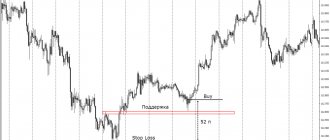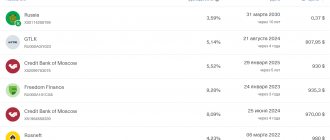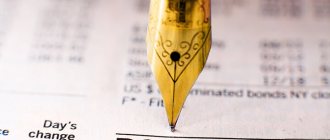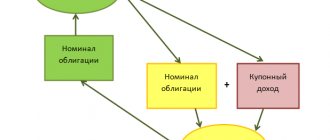Coupon bonds are the most common type of debt securities on the stock exchange. The income on such bonds is paid in regular installments until maturity. If securities need to be sold on the secondary market, the concept of accumulated coupon income (ACY) is used to determine their fair price.
Accumulated coupon income: what is it and why is it needed?
ANC on bonds is coupon income that has accumulated to date since the last coupon payment, but has not yet been paid to the bond owner.
This indicator is important when calculating the sale price of a bond. The investor can accurately determine the value of the security, taking into account the income not yet received, and sell it without waiting for the next coupon payment. The coupon will go to the future owner of the bond, but his actual income will be less by the amount of the NKD that was included in the sale price.
Method for calculating income tax on bonds
There are several ways to calculate the amount of accumulated coupon income. The specific method you choose depends on whether the coupon rate is fixed or variable. In the first case, the NKD can be calculated using the following formula:
NKD = Nominal * Coupon rate % / 100 * (Calculation date - Date of last payment) / 365.
The above equation is used to calculate ACI for fixed coupon bonds, which are the most common type of debt securities. Let's calculate the amount of accumulated coupon income using a specific example.
Let's say an investor needs to sell a bond with a nominal price of 1,500 rubles and an annual rate of return of 13%. The last coupon payment was made on 02/17/21, and the day of calculating the cash income tax was 03/30/21.
First you need to determine how many days have passed since the previous payment. In our case, 44 days. Next, we substitute all the data into the formula and get:
NKD = 1500 * 13/100 * 44/365 = 23.50 rubles.
This is the amount that needs to be added to the sale price of the bond in order not to lose the accumulated interest. An alternative option for calculating the accumulated coupon income would be to determine the income tax for 1 day and then multiply this indicator by the number of days since the previous payment.
How can you find out the NKD without using formulas?
For fixed coupon bonds, the ACI is quite simple to calculate, but even this requires time and basic knowledge. If the coupon income is variable and depends on various indicators, for example, on inflation, the RUONIA rate or the price of oil, more complex formulas are used to calculate the ACI.
There are two ways that allow you to find out the accumulated income on a bond coupon for a specific date and do not require independent calculations.
The first option is specialized resources, for example, rusbonds.ru. Here you can find the latest NCD for Russian bonds, as well as other useful information for investors.
The second way to find out the amount of income accumulated from a coupon is the Quick trading terminal. This is special software for investors that allows you to access online trading on the stock exchange. The Quick trading terminal has detailed information about bonds, including the ACD, which is shown in a separate column.
Who is a bond issuer?
The issuer of bonds is the person who issued them. Issuers of bonds are commercial organizations, often banks, as well as states and individual government bodies, regional authorities or departments. Individuals do not issue bonds, but only resell other people's securities.
Becoming a bond issuer is difficult. You need to obtain permission to issue bonds, register the issue, make an initial placement of bonds, register all this, etc.
This is much more difficult than taking out a loan or a loan. But thanks to this, it is easy to check the bond issuer; all data about him will be in the public domain.
Advantages of using NKD
Taking into account the accumulated coupon income when determining the price of bonds has advantages both for investors and for the market as a whole:
1. NKD allows you to determine the fair value of debt securities.
2. The use of this indicator helps to increase the liquidity of bonds. If the NCD were not used, sellers would be forced to wait until the next coupon payment date to sell the securities. And after interest accrual, there would be a significant bias in the market towards supply, as investors would strive to sell bonds as quickly as possible.
3. The investor does not lose interest income when selling debt securities. Since the accrued income is taken into account upon sale, the seller can exit the asset without loss and receive all accrued income.
The NKD makes it possible to make the bond market more balanced in terms of supply and demand, and also ensures a fair price for transactions.
We explain in the most accessible way what bonds are and how to make money on them
Bonds (in foreign sources you can find the term Bonds) are a conservative instrument, making money with which is quite simple. Bonds are often compared to a bank deposit, noting numerous advantages over the latter.
In practice, when working with bonds, a novice investor is faced with a large number of nuances and specific terms that significantly complicate the investment process and sometimes lead to painful mistakes.
Let's look at what bonds are using simple and understandable examples, and also define the key concepts of the debt market.
What are bonds
A bond is a debt security for which the borrower (the one who issues the bonds) must return to the creditor (investor) the cost of the bond (par value) and interest on the use of funds (coupon income) within a specified period.
Example. A friend comes to you and asks you to borrow 90,000 rubles - it’s not enough to buy a car. He will be able to return the money only in a year, and as a thank you he is ready to give not 90,000, but 100,000 rubles. You agree, and to record the agreement you make a receipt. This receipt states that on a certain date your friend will return you 100,000 rubles. Your friend receives the money, and you have a receipt in your hands. This receipt is essentially a bond. And the deal you entered into is a bond placement.
In the above example, RUB 100,000. is the face value of the bond. The amount that your friend (borrower) will return to you (investor). The date on which the debt will be repaid is called the maturity date.
The 90,000 you paid for the note is the issue price of the bond. The income on this security will be the difference between the redemption price and the placement price: 100,000 - 90,000 = 10,000 rubles. Bonds for which income is generated in this way are called discount or zero-coupon bonds.
Bond coupon is the percentage of the face value that the bond issuer pays to the investor for the use of funds. The coupon can be paid on a semi-annual basis, annually, quarterly or monthly.
In the example above, we will compose the receipt a little differently. After a year, your friend returns you not 100,000, but 90,000, as he borrowed, but once every three months he will pay you 2,500 as a reward for using the funds. That is, after 3, 6 and 9 months you will receive 2,500 rubles each, and after a year your friend will return your 90,000 rubles. and the last payment is 2,500 rubles. This quarterly payment will be called a coupon or coupon income.
To make it easier to compare bonds, the coupon is measured as a percentage per annum. In this example, you will receive 2,500 * 4 = 10,000 rubles as income. On the invested amount this will be 10,000/90,000 = 11.11% per year. In this case, it is customary to say that the coupon on this bond is 11.11% per annum.
Why is the yield on a bond called a coupon? Previously, bonds were held by investors in paper form. When the holder received payment from the issuer, a paper coupon was torn off the bond. Now bonds mostly exist in electronic form, but the term coupon is firmly entrenched in the lexicon of market participants. The vast majority of bonds on the Russian market are coupon bonds. Discount papers are quite rare.
Thus, we figured out that, in essence, a bond is a promissory note with certain conditions, the main ones of which are the maturity date, par value, size and frequency of coupon payment, and, of course, who is the issuer of this paper. The only point is that this receipt is a non-documentary security.
Basic parameters of bonds in the “Current trading” window of the QUIK terminal. The first column indicates the name of the issue, which usually includes the name of the issuer. From top to bottom: Sberbank, Rosneft, PIK Group, AFK Sistema, etc. “Coupon duration” - the period after which the next coupon is paid - is measured in days. The coupon size is indicated in rubles, and the bond price is indicated in%. The “Yield” column indicates the effective yield to maturity, the meaning of which will be described below.
Everyone is familiar with a simple economic law: the higher the risk, the higher the profitability, and vice versa.
This rule also applies to the bond market. The more reliable a bond issuer is, the lower the return it offers its investors. Conversely, if the risk of problems with the solvency of the issuer is high, then it has to pay a higher coupon on its debt securities in order to interest market participants.
The reliability of the issuer is also called credit quality - the higher it is, the lower the probability of bankruptcy. In Russia, the most reliable securities are considered to be federal loan bonds (OFZ), issued by the state represented by the Ministry of Finance. They are a kind of benchmark in the debt market.
To assess credit quality, issuers and individual bond issues are assigned credit ratings. This is done by special rating agencies that evaluate the financial performance of issuers, their debt load, legal risks, the state of the industry as a whole and many other factors.
The ratings of the three largest international agencies are considered to be the most authoritative in the world: Standard & Poor's, Moody's and Fitch.
Also, the yield of a bond depends on the period to maturity. The shorter the term to maturity, the lower, other things being equal, its profitability, since the risk of problems for the issuer in a short period of time is lower than in a longer period.
Features of bond circulation
Bonds are traded on the exchange and over-the-counter markets. If you are a bond holder and need to quickly return your investment, you can sell it to another investor and get money.
Since bond prices are determined by supply and demand, the market price often differs from the par value. For convenience, it is measured as a percentage of the nominal value. For example, if the market price of a bond is 101.53 and the face value is 1000 rubles, this means that the paper can currently be bought or sold for 101.53% * 1000 rubles. = 1015.3 rub.
If a bond is trading above par, it is said to be trading at a premium. If it is lower, the bond is said to be trading at a discount. Most bonds on the Russian market have a nominal value of 1000 rubles.
Market price of the bond
The market price of a bond is formed based on the level of required market yield for issuers of the appropriate credit quality.
The point is this. An investor will not buy bonds with a yield of 6% if there are alternatives on the market at 8% with the same level of reliability. In order for the holder to sell such a security, he will have to sell it at a discount, which will compensate the buyer for the difference in the yield of 2% per year until maturity.
Example: A bond was issued in early 2011 with a maturity date of 2016 with a coupon of 8%. At the beginning of 2015, the level of interest rates increased and for bonds of comparable credit quality the yield is 10% per year. Accordingly, for a bond to be of interest to investors, it must provide a similar return. But since the coupon was previously fixed at 8%, such a yield can only be achieved by reducing the cost of purchasing the bond.
To offset 2% per year for 2015 and 2016. the denomination should be reduced by approximately 2*2%=4%. Thus, the market price will be 96% of the face value. This example is very simplified, but allows you to understand the principle of pricing in the bond market.
Bond yield
Another issue that can cause confusion for a beginner is the concept of bond yield. There are several types of returns that are worth knowing.
Coupon yield
In essence, this is simply the value of the coupon. If the coupon on a bond is 8%, then the coupon yield will be similar. It is worth noting that regardless of the frequency of the coupon payment (quarterly, monthly, etc.), the investor can receive interest income on the bond for each day it is held.
When selling, investors include in the price the amount of interest accumulated during the period of ownership of the security since the last coupon. For securities of the same issue, the premium on the same day is always the same, so for convenience, in modern trading systems this value is calculated automatically and immediately taken into account in transactions. This premium is called accumulated coupon income (ACI).
Current yield
This is a simplified yield indicator that shows the coupon yield relative to the specific current market price of a bond. The assumption here is that the price of the bond will not change over time. Current yield is convenient to use if you buy a bond for a short period (up to six months) and plan to sell it long before maturity
Simple (nominal) yield to maturity
This yield includes not only the coupon income, but also the profit/loss from the difference between the redemption price and the market price at which the bond was purchased.
Effective yield to maturity - YTM
Effective yield to maturity is the most popular and most accurate for comparing bonds. In most resources, the concept of profitability means exactly that. Unlike the previous indicator, it takes into account the reinvestment of coupons - it is assumed that the received coupons can be immediately invested in bonds at the same yield.
The effective yield formula is quite cumbersome, and the average investor does not need to know it - it can be viewed in QUIK, on the Moscow Exchange website or on specialized resources such as cbonds or rusbonds, where it is calculated automatically.
Bond classification
By type of issuer, bonds are government, corporate and municipal.
By maturity, bonds are divided into short-term (up to 1 year), medium-term (1 to 5 years) and long-term (more than 5 years).
Depending on the type of income, bonds can be either discount or coupon. There are also securities with a variable coupon, floating coupon, indexed par value, etc.
By par currency, bonds can be denominated in rubles and quoted in other currencies, most often in US dollars. Bonds that are quoted in other currencies are called Eurobonds.
Read more: Types of bonds on the Russian market
Risks of investing in bonds
Credit risk is the risk of deterioration in the issuer's solvency. If the risk that the issuer may default on its debt increases, the price of the bond may decline. If the issuer's credit rating has been downgraded, the price will drop slightly, but if there is a serious risk of bankruptcy, the value of the bonds may fall significantly.
Interest rate risk is the risk that the value of a bond will decline due to changes in interest rates. The further the maturity date and the lower the coupon on the bond, the higher this risk. It can be assessed by the duration indicator.
Liquidity risk - Most of some bond issues are concentrated in the hands of large investors who plan to hold them for the long term. In this case, the trading turnover of these securities on the exchange will be very low and selling/buying a more or less large volume at the desired price may be problematic.
Risk of execution of built-in options - read more about the put offer.
Inflation risk - when purchasing bonds with a constant coupon, there is a risk that inflation will rise and begin to overtake the income on the portfolio. To protect against this risk, you can form part of the portfolio from bonds with a floating coupon linked to the inflation rate.
What to look for first when choosing a bond for your portfolio
— Assess the level of required return and acceptable risk. Based on this, it is already possible to consider the securities of certain issuers. As a rule, the more the yield of a bond exceeds the yield of the corresponding OFZ, the higher the risk.
— Give preference to large issuers whose solvency does not raise questions.
— Assess your investment horizon and select securities whose maturity date approximately coincides with your goals.
— Assess the liquidity of the bonds you are considering purchasing. Are daily trading volumes sufficient? How often do transactions take place? How quickly can you sell securities if necessary without loss in price?
— If, in your opinion, interest rates on the market will rise, you should give preference to short-term issues or securities with floating rates. If you think interest rates in the market will fall, you can allocate part of your portfolio to longer-term securities in order to receive additional income due to their rising prices.
— When trading bonds, keep in mind that coupon income on corporate securities issued after January 1, 2022 is not taxed. Also, income from coupon income on OFZs and municipal bonds is not taxed.
— Don’t forget to take into account the costs of exchange and brokerage commissions.
— Do not try to use technical analysis to trade bonds. This tool doesn't work here.
Start investing
BCS World of Investments











